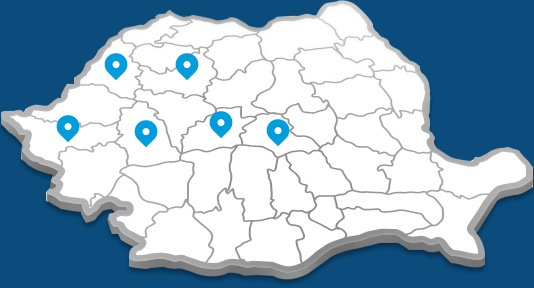I love my city:
With what it gave me,
With what it took from me.
Inspired by Mircea Golban
Articol și prezentare video realizate de Paul-Daniel Golban, în cadrul concursului internațional „Moștenirea mea locală” din cadrul proiectului european LoCloud, susținut de www.europeana.eu
Panorama of the city. The history of the settlement of Cluj-Napoca goes as far as the Paleolithic. The earliest Neolithic findings from our country were discovered also around the town. The Roman period leaves important traces in its development. The old Roman Castrum developed into a flourishing town. During the centuries the town had an agitated history, but its development is ascending, marked by its architectural monuments still existing in our days. The personality of the city and its historical atmosphere is illustrated by the next photographs of the monuments.
Cluj-Napoca. Istoria așezării umane a Clujului coboară până în vremea paleoliticului. Cele mai vechi relicve neolitice de pe teritoriul patriei au fost descoperite tot în zona orașului. Epoca romană lasă urme adânci în dezvoltarea lui. Vechiul catru roman se transformă într-un oraș în plină înflorire. Pe parcursul secolelor orașul are o istorie zbuciumată, dar dezvoltarea lui, marcată de monumentele arhitecturale existente și în prezent, este ascendentă. Personalitatea orașului și atmosfera istorică este ilustrată în următoarele fotografii ale monumentelor.
Saint Michael’s Church. Was built between 1350 and 1480 in Gothic style. The simplicity of its outside and inside decoration gives a concise and secure exterior to this second size Gothic church in Transylvania after the Black Church from Brașov. Instead of the usual crossribbed vault the second stellar vault was built in 1498. Becomes the victim of a fire in 1497. Was restored inside and outside between 1740-50, and the old pulpit was transformed in Baroque style. The portal of the vestry, built in 1528 is the most well-known monument of Cluj-Napoca. The 80 m high tower, built between 1834-63, is the highest in Transylvania. Its chapel, according to the fresco, was built in the 15th-16th century.
Biserica Sfântul Mihail. A fost construită între 1350-1480 în stil gotic. Simplitatea ornamentațiilor exterioare și interioare îi conferă aspectul de consistență și siguranță acestei biserici cu ogive, cea mai mare de acest gen îm Transilvania, după Biserica-Neagră din Brașov. În 1498 a fost construită bolta în formă stelată (gotic târziu) în locul bolții intersectate obișnuite. În 1697 este mistuită de un incendiu, între 1740-50 este restaurată, iar amvonul vechi primește o haină barocă. Ușa sacristiei, executată în 1528, este cel mai cunoscut monument de artă din Cluj. Turnul neogotic de 80 m, construit între 1834-63, este cel mai înalt din Transilvania. Capela bisericii, după mărturia frescei din interiorul ei, datează aprox. din 1400.
Statue of King Mathias. The equestrian statue of the legendary Matthias Corvinus, who lived between 1443-90 and reigned between 1458-90, is the masterpiece of the well-known sculptor Fadrusz Janos. Built from a country-wide donation, was unveiled in the autumn of 1902. The figure of king sitting on a horse rises from a bastion-shaped socle. Around him, as it is supposed, one can find his generals: Magyar Balazs, Kinizsi Pal, Zapolya Istvan and Bathory Istvan. The king is looking attentively forward in his timeless monumentality while life is passing on at the legs of his horse.
Statuia lui Matei Corvin. Statuia ecvestră a lui Matei Corvin (1443-90), rege cu faimă legendară al Ungariei între 1458-90, este opera sculptorului de talie europeană Fadrusz Janos. Statuia finanțată din colectă publică a fost dezvelită în anul 1902. Pe un postament aducând a bastion se înalță imaginea regelui călare. Mai jos, în jurul său sunt imortalizați, după toate probabilitățile, conducătorii de oști, voievodul Transilvaniei Bathory Istvan, voievodul Magyar Balazs, banul Timișului Kinizsi Pavel, palatinul Zapolya Istvan. Într-o monumentalitate în afara timpului, regele privește atent în față, în timp ce la picioarele calului său freamătă viața trecătoare.
Birthplace of King Matthias. Built in the first half of the 15th century, is the oldest Baroque styke store-house in Cluj. The vault and the ogival part of the portal is a hundred years older. In the memoryof King Matthias’ birth in 1467 was exempted from taxes. The town settles a hospital in it about 1740. Convicts were guarded here about 1830. It is a military hospital in 1849. An artistic memoral tablet was mounted on it in 1888. According to the tradition King Matthias was born in the room left to the portal. Today is the centre of Ion Andreescu fine arts academy./ The University of Arts and Design
Casa natală a lui Matei Corvin. Construită în prima jumătate a sec. XV, este cea mai veche clădire etajată în stil baroc din Cluj. Partea în ogivă delimitată de arce din piatră și bolta cilindrică din pasajul intrării sunt mai vechi cu cca. 100 de ani. In memoria regelui Matei în 1467 este scutită de orice impozit. În jurul anului 1740 intră în posesia orașului care o utilizează ca spital. Din anii 1830 aici erau încarcerați deținuții cu condamnări grele. Din 1849 devine spital militar. Placa memorială se datează din 1888. Datina spune că, regele Matei s-a născut în camera spre fronton din stânga porții. În prezent clădirea adăpostește sediul Institutului de Arte Plastice Ion Andreescu.
Orthodox Cathedral. The building is impressive with its vertical setting stressed by the tambour of the cupola surrounded by a cloister. Consacrated to Virgin Mother, built between 1923-1933 after the plans of Constantin Pomponiu and George Cristinel is a successful mixture of romanic and byzantine style. The main structure of the church is made by reinforced concrete and built with brick. The outside of the church is worked in log squared stone. The carving brings to mind the outlines of old Romanian monuments. The inside is characterized by rich ornamental work carved in stone.
Catedrala Ortodoxă. Clădirea impresionează prin avântul ei spre înălțime accentuată și de turnul cu cupolă înconjurată de un peristil cu arcade. Biserica cu hramul Adormirea Maicii Domnului a fost construită între anii 1923-33 după proiectul arhitecților Constantin Pomponiu and George Cristinel, și îmbină cu success caracteristicile stilului roman și al celui bizantin. Structura de rezistență este din beton armat completată cu zidărie de cărămidă. Suprafața exterioară este placată cu dale de piatră reprezentând modele inspirate din vechi monumente românești. Ornamente bogate, sculptate în piatră, conferă interiorului o notă caracteristică.
National Theatre. It was designed and built by the Vieneze firm Fellner & Helmer (Cluj was also known as Little Vienna). It is a typical Secessionist building also including Eclectic elements as for instance the main façade decorations, the two towers crowned with a quadriga drawn by lions or the sumptuous hall. After its last performance in the small theatre on the 17th of June 1906, the Cluj company moved here. It was opened on the 8th September 1906. On the opening performance played Szentgyörgyi Istvan too. Today it belongs to the National Theatre and Opera.
Teatrul Național. A fost proiectat și construit de de către firma Fellner și Helmer din Viena (Clujul mai e cunoscut și drept Mica Vienă). Este o clădire caracteristică secesiunii vieneze de tip Art Nouveau care cuprinde și forme eclectice, ca de exemplu elementele ornamentale ale fațadei principale, turnurile care se înalță pe cele două aripi ale clădirii, încoronate ca carul tras de lei al muzelor, precum și foaierul somptuos. Trupa de teatru din Cluj s-a mutat în această clădire după ultimul spectacol, ținut la 17 iunie 1906 în vechiul „cerc teatral“. A fost inaugurat la 8 sept. 1906. La acest spectacol a jucat și Szentgyörgyi Istvan. În present adăpostește Teatrul Național și Opera Română.
Tailor’s Bastion. Due to the Turkish threatening, up to the end of the 15th century precincts and bastions were built serving the strenghthening of Cluj. From these remained only a part of the southern walls and bastion defended by the tailor’s guild. The 12 tons of gunpowder kept here were blewn up due to a thunderbolt and destroyed it in 1625. As a memorial tablet says it in Latin on the south-eastern part of the bastion, it was rebuilt in 1629. Its last military part was in 1707 when was blewn up by Kuruts general Karolyi Sandor to prevent getting it in the hands of pro-Austrians. It gots its present day shape in 1718.
Bastionul Croitorilor. Datorită amenințării turcești până la sfârșitul sec. XV s-a construit un zid și mai multe bastioane în vederea întăririi Clujului. Dintre acestea s-a păstrat bastionul apărat de breasla croitorilor, cu o parte a zidului sudic al cetății. În 1625, lovit de trăsnet, explodează 12 t de praf de pușcă depozitat în el și îl dărâmă până la temelie. Până la 1629 se reconstruiește, după cum stă scris în limba latină pe placa comemorativă pe partea sud-estică a construcției, purtând stema Clujului. Atunci a primit denumirea de bastion Bethlen. Ultimul rol l-a jucat în 1707 când generalul Karolyi Sandor l-a aruncat în aer, ca să nu ajungă pe mâna labanților. Forma sa de astăzi și-a dobândit-o în 1718.
Reformed Church. Its construction was began by King Matthias in 1486. The Gothic style church was destinated to the Minorite order. In 1580 it was given by reigning prince Bathory Istvan to the Jesuits. It gets in the possession of reformeds during the reformation. The tower and the monastery damaged during the religious conflicts of the 17th century, were demolished in 1644. Then, the crown of the interior furniture, the Renascence pulpit was built. Rakoczi György the first gave it to the Calvinists. It is the biggest hall-church from Transylvania (34 m long and 19 m high net vaulting). The walls are decorated by funeral emblems from the 17th-18th century.
Biserica Reformată din Centru. Construcția sa a fost începută de regele Matei în 1486. Biserica în stil gotic a fost destinată ordinului minoriților (ordin franciscan). Principele Bathory Istvan o doneaza iezuiților în anul 1580. În perioda reformei protestante ajunge în posesia reformaților. Turnul și clădirea mănăstirii degradate în cursul confruntărilor religioase sunt demolate în 1644. Atunci se construiește și adevărata comoară a interiorului bisericii: amvonul (balcon) în stilul renașterii. Rakoczi György I donează calviniștilor biserica. Este cea mai mare biserică gotică tip „hală“ din Transilvania (boltă tip plasă pe o suprafață de 34×15 m și înălțime de 19 m). Pereții bisericii sunt împodobiți cu blazoane nobiliare din sec. XVII-XVIII.
Saint George’s Statue. Our oldest statue is the authentic copy of the statue from Hradsin-Prague representing St. George killing the dragon. The original, the sole still existing work of the sculptor brothers Marton and Györgi from Cluj, was made in 1373 by the order of king Louis the Great. Its proved that it kept decorative elements from the time of the Hungarian settlement. On a miniature from “Illustrated Chronicle” representing the arrival of the Hungarians, the long, tressy hair of St. George could be find twice. Also proves for the Hungarian origin are the horse-furniture and the saddle and the knotting of the horse’s tail, which resemble to the findings from the migration period.
Statuia Sf. Gheorghe. Este cel mai vechi vestigiu de sculptură al orașului, copie autentică a statuii Sf. Gheorghe, odinioară în Hradsinul din Praga. Originalul, singura operă rămasă a sculptorilor clujeni Martin și Gheorghe, s-a făcut la comanda regelui Ludovic cel Mare în 1373. A păstrat în mod cert elemente ornamentale din perioada migrațiunii maghiare. Pe miniature care reprezintă intrarea maghiarilor în „Cronica ilustrată“, datând din aceeași perioadă, pieptănătura Sfântului Gheorghe în împletituri lungi, apare chiar de două ori. De asemenea, originea maghiară este indicată și de harnașamentul calului, ca și modul de împletire a cozii acestuia, imagini asemănătoare cu vestigii din era migrației popoarelor.
Banffy Palace. J.E. Blaumann built it between 1774-86 by the commission of Banffy György. Its façade has almost 50 m. A three opening portal leads to its yard, above with a columned and covered balcony on its roof with the blazon of the family. The Rococo façade is decorated by the statues of Hercule, Apollo, Mars, Minerva, Perzeus and Dianna symbolizing the virtues of the proprietor. On the floor the square yard is sourrounded by a column corridor. The building has a high garret roof. The balcony of the rear portal is supported by griffons, taken from the blazon of the family. Today used as a Fine Art Museum it’s the most beautiful Baroque palace from Transylvania.
Palatul Banffy. Din însărcinarea contelui Banffy György a fost construit de către J.E. Blaumann între 1774-86. În central frontonului lung de 50 m, deasupra porții principale cu trei deschideri este o logie cu coloane și pe acoperișul acesteia blazonul familiei. Impozantul fronton în stil rococo este împodobit cu statuile Hercule, Apolo, Marte, Minerva, Perseu și Diana, vrând să sugereze virtuțile proprietarului. Curtea interioară dreptunghiulară este mărginită la etaj de o colonadă. Acoperișul mansardat întregește frumoasele proporții ale construcției. Este considerat cel mai frumos palat baroc din Transilvania. În present adăpostește Muzeul de Artă.
Bothanical Garden. Its foundation can be dated after the establishment of the Transylvanian University (1872). It began on a surface of 4.3 ha. in the time of prof. Istvanffy (1897-99). Durign the directorship of Richter Aladar (1910-12) was enlarged with 9.7 ha. The work stopped during the First World-War and in 1920 prof. Al. Borza and head-gardener C. Gürtler made new plans. The work ended in 1930, but the public could visit the garden since 1925. Its herbarium and seed-collection is well-known, it has connections with many countries of the world. Is one of the most important touristic sights of the city.
Grădina Botanică. A fost întemeiată în perioada înființării universității din Transilvania (1872). Pe vremea prof. Istvanffy (1897-99) a avut o suprafață de 4,3 ha. Între 1910-12 sub direcția lui Aladar Richter s-a extins cu 9,7 ha. Lucrările au fost sistate în perioda primului război mondial, iar în 1920 prof. Al. Borza și grădinarul șef C. Gürtler au întocmit un plan nou. Lucrările s-au terminat în 1930, dar grădina botanică ― destinată în primul rând cercetării ― era deschisă publicului din 1925. Sunt renumite ierbariul și colecția de semințe ale grădinii. Ține legături cu instituții similar din numeroase țări ale lumii. Este una dintre cele mai cunoscute atracții turistice ale orașului.
Ethnographic Museum. It was established as the first ethnographic museum from Romania in 1922. The „National Ethnographic Parc“ was established, as part of the museum in 1929, which was also the first open-air museum from Romania. Farms from representative ethnographical regions of Transylvania, wooden-churches and traditional technologies are the main sections of the museum. It gives a synthetic image of the Transylvanian village, of the rural civilization from the inside of the Carpathian curve. Interesting water-actioned installations are exposed: mills, oil-presses, sawmills, fulling mills.
Muzeul Etnografic al Transilvaniei. A fost înființat în 1922 și este primul muzeu etnografic din România. În 1929 ia ființă „Parcul Național Etnografic“, parte integrantă a Muzeului, care este de asemenea primul muzeu în aer liber din România. Gospodării din zonele etnografice representative ale Transilvaniei, biserici de lemn, tehnologii tradiționale sunt principalele sectoare ale Muzeului. O imagine sintetică a satului transilvan, a civilizației rurale din întreaga curbură a Carpaților. Sunt expuse interesante instalații construite din lemn și antrenate de apă: mori, prese de ulei, gatere, piue etc.











